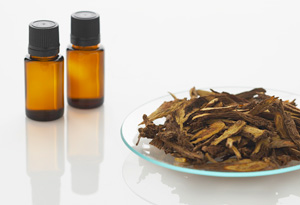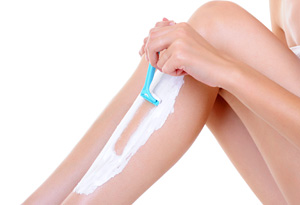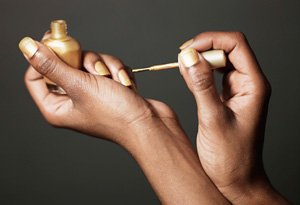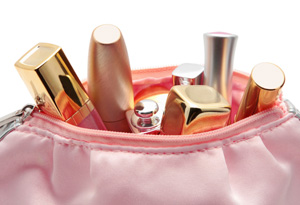Shift Your Habit to Improve Your Love Life

Love is big business! Last we checked, the beauty industry generated $160 billion with no signs of slowing down. To add value and smarts—and money—back into your life, try these simple changes from Shift Your Habit author Elizabeth Rogers. These shifts are designed to show you how to look good, feel good and live better for less. Here's to love and happiness!
Smell BetterBuy fragrance made from organic essential oils instead of name-brand perfume made from synthetic fragrance. You'll save $30 or more per ounce.
Essential oils made from organically grown herbs or flowers are free from the harmful chemicals used on conventionally raised flora, as well as from phthalates, which are associated with synthetic perfumes and fragrances. Certain phthalates are suspected carcinogens and can lead to hormonal and reproductive system disorders.

Kill the Dye
Buy an at-home haircolor kit instead of heading to the salon to get your hair dyed, and save $1,500 or more per year.
Not only will you save gas driving to the salon—assuming you buy your haircolor kit when you're already at the drug store—but most salons use chemically laden hair dyes that are potentially harmful to human health. One recent study reported that women who used permanent hair dye were twice as likely to contract bladder cancer as those who didn't color. When you do it yourself, you have the option of purchasing a haircolor kit made with plant-based, nontoxic ingredients.
Buy an at-home haircolor kit instead of heading to the salon to get your hair dyed, and save $1,500 or more per year.
Not only will you save gas driving to the salon—assuming you buy your haircolor kit when you're already at the drug store—but most salons use chemically laden hair dyes that are potentially harmful to human health. One recent study reported that women who used permanent hair dye were twice as likely to contract bladder cancer as those who didn't color. When you do it yourself, you have the option of purchasing a haircolor kit made with plant-based, nontoxic ingredients.

Laser Sharp
Invest in laser hair removal instead of waxing and save $1,500 to $2,500 for 10 years of hair removal treatment.
The paraffin wax used for hair removal is derived from petroleum, which is a nonrenewable resource, while the electricity used during laser treatment is roughly equivalent to that of a standard light bulb. And it's a change that lasts. Laser treatment can achieve permanent hair removal, whereas waxing must be done every five to six weeks.
Invest in laser hair removal instead of waxing and save $1,500 to $2,500 for 10 years of hair removal treatment.
The paraffin wax used for hair removal is derived from petroleum, which is a nonrenewable resource, while the electricity used during laser treatment is roughly equivalent to that of a standard light bulb. And it's a change that lasts. Laser treatment can achieve permanent hair removal, whereas waxing must be done every five to six weeks.

Razor's Edge
Ditch disposable razors or refillable blades replaced weekly, and buy a rechargeable or plug-in electric razor instead. You can save a total of about $80 a year, or roughly the cost of a decent electric razor.
You'll help the planet by cutting your use of: 1,000 gallons of water (no need to run the hot water when you have an electric razor), 150 pounds of carbon dioxide from water heating energy and about 5 pounds of waste (razors, packaging and shaving cream containers). You'll save time too! Shaving with an electric razor tends to be much quicker than shaving with a disposable one.
Ditch disposable razors or refillable blades replaced weekly, and buy a rechargeable or plug-in electric razor instead. You can save a total of about $80 a year, or roughly the cost of a decent electric razor.
You'll help the planet by cutting your use of: 1,000 gallons of water (no need to run the hot water when you have an electric razor), 150 pounds of carbon dioxide from water heating energy and about 5 pounds of waste (razors, packaging and shaving cream containers). You'll save time too! Shaving with an electric razor tends to be much quicker than shaving with a disposable one.

Nailing It
Buy nail polish free of dibutyl phthalates and toluene instead of standard brand-name polish made with standard toxins. Nail polishes are among the most dangerous cosmetics. Toluene is linked to cancer, and both toluene and dibutyl phthalates are associated with developmental toxicity. You'll save up at least $10 a year, but the real savings are ecological. Fewer toxic chemicals means reduced risk of damage to wildlife, fish and ecosystems.
Buy nail polish free of dibutyl phthalates and toluene instead of standard brand-name polish made with standard toxins. Nail polishes are among the most dangerous cosmetics. Toluene is linked to cancer, and both toluene and dibutyl phthalates are associated with developmental toxicity. You'll save up at least $10 a year, but the real savings are ecological. Fewer toxic chemicals means reduced risk of damage to wildlife, fish and ecosystems.

Bar None
Buy bars of soap instead of a plastic bottle of body wash and save up to $50 per year for a family of four and reduce waste. Bars of soap are usually minimally packaged in recyclable paper or cardboard, whereas body wash almost always comes in a plastic bottle.
Buy bars of soap instead of a plastic bottle of body wash and save up to $50 per year for a family of four and reduce waste. Bars of soap are usually minimally packaged in recyclable paper or cardboard, whereas body wash almost always comes in a plastic bottle.

Makeup Shakeup
Instead of hauling around a makeup bag brimming with pencils and tubes, invest in some multiuse products. Why use a separate eyeshadow, lipcolor and blush when you can get all three in one skinny stick?
You'll save $100 or more per year compared to buying individual makeup products and use half as many products—meaning consuming half as much packaging. Many multiuse compacts are also refillable, which means even less waste!
Instead of hauling around a makeup bag brimming with pencils and tubes, invest in some multiuse products. Why use a separate eyeshadow, lipcolor and blush when you can get all three in one skinny stick?
You'll save $100 or more per year compared to buying individual makeup products and use half as many products—meaning consuming half as much packaging. Many multiuse compacts are also refillable, which means even less waste!

Don't Count Sheets
Choose 300-count sheets instead of 600-count or higher. High thread count claims may be inflated or manufactured with thinner, lower-quality threads. Sheets made from Egyptian cotton or American-grown pima cotton are the best, regardless of thread count. They have the longest fibers, which mean they'll last the longest, and they'll save you about $100 per sheet set depending on brand and size.
Longer-lasting sheets, by definition, need to be replaced less frequently. Growing cotton requires energy, water, land and large quantities of agrochemicals. Processing, sewing and transport (most cotton items are made overseas) involve additional energy and resources. How is this good for you? If you're not buying super-expensive sheets, you're staying away from luxury linen departments—which can be major money suckers.
Choose 300-count sheets instead of 600-count or higher. High thread count claims may be inflated or manufactured with thinner, lower-quality threads. Sheets made from Egyptian cotton or American-grown pima cotton are the best, regardless of thread count. They have the longest fibers, which mean they'll last the longest, and they'll save you about $100 per sheet set depending on brand and size.
Longer-lasting sheets, by definition, need to be replaced less frequently. Growing cotton requires energy, water, land and large quantities of agrochemicals. Processing, sewing and transport (most cotton items are made overseas) involve additional energy and resources. How is this good for you? If you're not buying super-expensive sheets, you're staying away from luxury linen departments—which can be major money suckers.

Unscrew Around
Even though things may look a bit bare (I prefer to think of it as "minimalist"), you can cut your energy consumption significantly—and save up to $90 in electricity costs, as well as the costs of bulb replacement—by disabling half of the bulbs in multibulb light fixtures.
You will conserve an estimated 875 kilowatt-hours of energy by eliminating 10 60-watt bulbs that are normally on for an average of four hours per day. But be sure to leave enough illumination so that your eyes aren't strained.
Even though things may look a bit bare (I prefer to think of it as "minimalist"), you can cut your energy consumption significantly—and save up to $90 in electricity costs, as well as the costs of bulb replacement—by disabling half of the bulbs in multibulb light fixtures.
You will conserve an estimated 875 kilowatt-hours of energy by eliminating 10 60-watt bulbs that are normally on for an average of four hours per day. But be sure to leave enough illumination so that your eyes aren't strained.

Feed Each Other
Share a meal with your date and save $25 or more each time out. You will either prevent food from being wasted or avoid the burden of carting home an oversize foam to-go box that will inevitably be crammed into an undersize trashcan.
It's not only about being good. You'll also save room for dessert! Plus, what's less romantic than the car stinking of garlic the next morning because you forgot to take in the leftovers?
Share a meal with your date and save $25 or more each time out. You will either prevent food from being wasted or avoid the burden of carting home an oversize foam to-go box that will inevitably be crammed into an undersize trashcan.
It's not only about being good. You'll also save room for dessert! Plus, what's less romantic than the car stinking of garlic the next morning because you forgot to take in the leftovers?

Joy to the Soy
Buy soy candles instead of paraffin wax candles. You can save $10 for equivalent burn time. And soy wax burns cleanly, emitting 90 percent less pollution than paraffin wax candles, which are made from petroleum and are as dirty as diesel exhaust. Soy is a renewable resource, whereas paraffin is nonrenewable, made from crude oil. Another benefit is improved indoor air quality and reduced exposure to the 11 carcinogenic compounds associated with paraffin wax candle soot.
Elizabeth Rogers is the co-author of The Green Book. Her latest book, Shift Your Habit, is about a new way of thinking that leads to both saving money and living consciously.
Keep Reading:
Simran Sethi's guide to buying eco-friendly soy candles
Green is the new chic! Earth-friendly fashion
O magazine's Adam Glassman shows the way to ethical fashion
Buy soy candles instead of paraffin wax candles. You can save $10 for equivalent burn time. And soy wax burns cleanly, emitting 90 percent less pollution than paraffin wax candles, which are made from petroleum and are as dirty as diesel exhaust. Soy is a renewable resource, whereas paraffin is nonrenewable, made from crude oil. Another benefit is improved indoor air quality and reduced exposure to the 11 carcinogenic compounds associated with paraffin wax candle soot.
Elizabeth Rogers is the co-author of The Green Book. Her latest book, Shift Your Habit, is about a new way of thinking that leads to both saving money and living consciously.
Keep Reading:
Simran Sethi's guide to buying eco-friendly soy candles
Green is the new chic! Earth-friendly fashion
O magazine's Adam Glassman shows the way to ethical fashion



